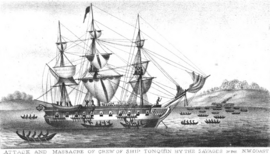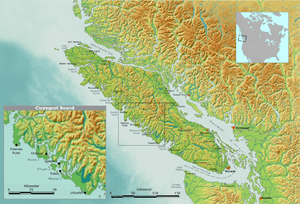Battle of Woody Point facts for kids
Quick facts for kids Battle of Woody Point |
|||||||
|---|---|---|---|---|---|---|---|
| Part of The Maritime Fur Trade | |||||||
 The Tonquin being boarded by Tla-o-qui-aht |
|||||||
|
|||||||
| Belligerents | |||||||
| Pacific Fur Company | Nuu-chah-nulth | ||||||
| Commanders and leaders | |||||||
| unknown | |||||||
| Strength | |||||||
| 1 barque | 2 war-canoes | ||||||
| Casualties and losses | |||||||
| 29 killed 1 bark scuttled |
~200 killed or wounded | ||||||
The Battle of Woody Point was an event that happened in western Canada in June 1811. It involved the Tla-o-qui-aht people of the Pacific Northwest and an American merchant ship called the Tonquin. This ship belonged to the Pacific Fur Company.
The Tonquin had sailed to Clayoquot Sound near Vancouver Island. Its goal was to trade for furs with the local people. During the trading, an argument started. The Tla-o-qui-aht then took control of the ship. They killed most of the crew. One sailor who was still alive then sank the ship. He did this by blowing up the powder storage area.
Why the Battle Happened
On March 22, 1811, the ship Tonquin arrived at the Columbia River. It was a 290-ton barque, a type of sailing ship. The ship was led by Lieutenant Jonathan Thorn. Their plan was to trade with the native people along the northern Pacific coast. To do this, they needed to set up a trading post.
After exploring the river's mouth, the traders built Fort Astoria. This was the first time Americans claimed land on the Pacific coast. The Tonquin had left New York the September before. It made short stops in the Falkland Islands and the Hawaiian Islands. Lieutenant Thorn had problems with his crew during the trip. He even left some sailors on the Falkland Islands. He only brought them back after other crew members made him.
Once their base was set up, the traders could explore the area. They were looking for valuable furs.
At the time of the battle, the Tonquin had twenty-three crew members. It also carried ten cannons. Even though the ship flew an American flag and had a United States Navy officer in charge, most of the crew were British. On June 5, the Tonquin left Fort Astoria. It sailed north to trade with the Nuu-chah-nulth people near Nootka Sound. About two weeks later, near Woody Point off Vancouver Island, the Tonquin began trading with the Tla-o-qui-aht Nuu-chah-nulth.
The Battle Begins
On June 14, a Tla-o-qui-aht chief came aboard the Tonquin. Lieutenant Thorn wanted to buy sea otter furs from the native people. However, he was not happy with the price of the furs. He waved or tossed the fur he was looking at back at the chief. The chief seemed to feel insulted and left the ship.
Later that night, a native woman came onto the ship. She warned Lieutenant Thorn that the Nuu-chah-nulth were planning to attack the ship the next day. Thorn did not believe the woman. But the next day, many native warriors were seen on the coast.
Since Thorn still did not think the Nuu-chah-nulth were dangerous, he allowed a large canoe with over twenty native men to come to the ship to trade. Another canoe with about twenty more men followed them. The first group of twenty men boarded the ship. They had their weapons hidden under their clothes. They pretended to trade furs and sold them very cheaply. Thorn had been told not to let too many native people on board at once, but he did not follow these orders.
Lieutenant Thorn was happy with the low prices he was getting for the furs. He realized the danger the ship was in too late. He quickly gave orders to raise the anchor and sails. At that moment, the Nuu-chah-nulth chief gave a signal to attack.
Alexander McKay, James Lewis, Thorn, and most of the crew were killed quickly. This was because they were mostly unarmed. Thorn had kept the guns below deck. The Nuu-chah-nulth used clubs and knives. A few crew members who survived started to fight back from below deck. This was where the rifles and powder were stored. The Nuu-chah-nulth then went back to shore as night came.
Five men were still alive, but one was badly hurt. They talked about what to do. They knew they could not sail the ship with so few people. They decided that four of them would leave in one of the ship's small boats. They planned to leave under the cover of darkness. They hoped to make it back to Fort Astoria by sailing along the coast.
The wounded man, possibly the ship's armourer named Weeks, stayed on the Tonquin. The Nuu-chah-nulth returned the next morning to take things from the ship. While they were busy taking items, Weeks lit the ship's large black powder storage area. A huge explosion destroyed the ship. Weeks and many of the native people were killed in the blast. The Nuu-chah-nulth later said that at least 100 of their people died. Many more were hurt. Other reports say between 61 and over 200 native people were killed.
The four sailors in the small boat were pushed ashore by a storm further down the coast. They were then captured by the Nuu-chah-nulth. As revenge for the explosion, they were killed. Of the thirty crew members on the Tonquin, only one man survived. He was a half Chinook pilot and interpreter. His name was Lemazee, or George Ramsey, and more recently identified as Joseachal. During the first attack, he gave himself over to a Nuu-chah-nulth woman. He asked to be made a slave. Joseachal was later set free. He told his story to Gabriel Franchère.
See also
- American Indian Wars
- John R. Jewitt, whose ship the Boston was captured and the crew killed a few years before


